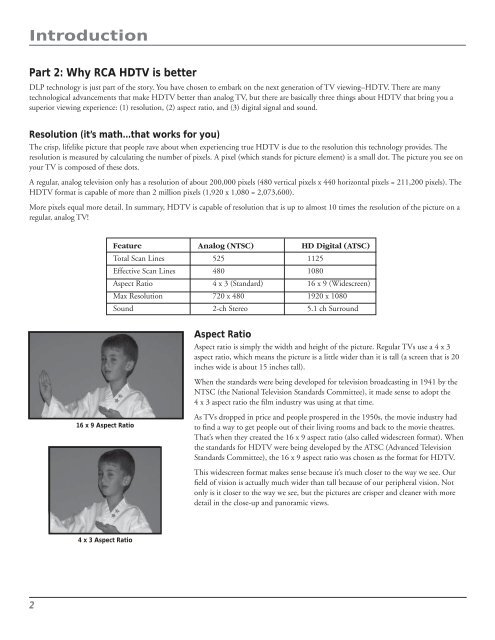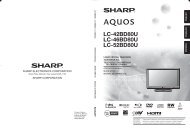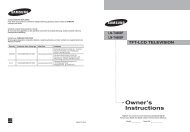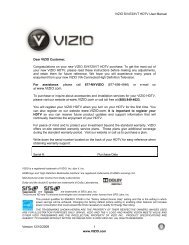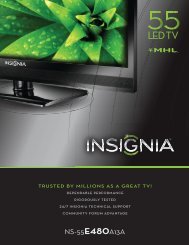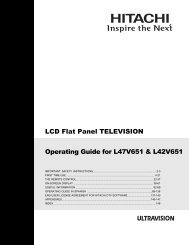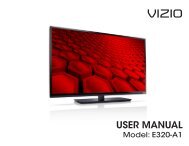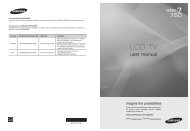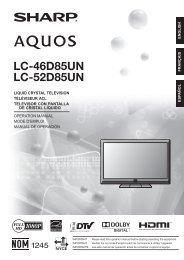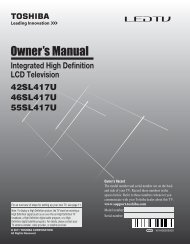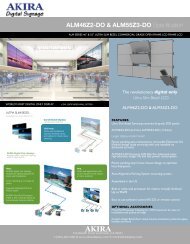You also want an ePaper? Increase the reach of your titles
YUMPU automatically turns print PDFs into web optimized ePapers that Google loves.
Introduction<br />
Part 2: Why RCA HDTV is better<br />
DLP technology is just part of the story. You have chosen to embark on the next generation of TV viewing–HDTV. There are many<br />
technological advancements that make HDTV better than analog TV, but there are basically three things about HDTV that bring you a<br />
superior viewing experience: (1) resolution, (2) aspect ratio, and (3) digital signal and sound.<br />
Resolution (it’s math...that works for you)<br />
The crisp, lifelike picture that people rave about when experiencing true HDTV is due to the resolution this technology provides. The<br />
resolution is measured by calculating the number of pixels. A pixel (which stands for picture element) is a small dot. The picture you see on<br />
your TV is <strong>com</strong>posed of these dots.<br />
A regular, analog television only has a resolution of about 200,000 pixels (480 vertical pixels x 440 horizontal pixels = 211,200 pixels). The<br />
HDTV format is capable of more than 2 million pixels (1,920 x 1,080 = 2,073,600).<br />
More pixels equal more detail. In summary, HDTV is capable of resolution that is up to almost 10 times the resolution of the picture on a<br />
regular, analog TV!<br />
Feature Analog (NTSC) HD Digital (ATSC)<br />
Total Scan Lines 525 1125<br />
Effective Scan Lines 480 1080<br />
Aspect Ratio 4 x 3 (Standard) 16 x 9 (Widescreen)<br />
Max Resolution 720 x 480 1920 x 1080<br />
Sound 2-ch Stereo 5.1 ch Surround<br />
Aspect Ratio<br />
Aspect ratio is simply the width and height of the picture. Regular TVs use a 4 x 3<br />
aspect ratio, which means the picture is a little wider than it is tall (a screen that is 20<br />
inches wide is about 15 inches tall).<br />
When the standards were being developed for television broadcasting in 1941 by the<br />
NTSC (the National Television Standards Committee), it made sense to adopt the<br />
4 x 3 aspect ratio the film industry was using at that time.<br />
16 x 9 Aspect Ratio<br />
As TVs dropped in price and people prospered in the 1950s, the movie industry had<br />
to find a way to get people out of their living rooms and back to the movie theatres.<br />
That’s when they created the 16 x 9 aspect ratio (also called widescreen format). When<br />
the standards for HDTV were being developed by the ATSC (Advanced Television<br />
Standards Committee), the 16 x 9 aspect ratio was chosen as the format for HDTV.<br />
This widescreen format makes sense because it’s much closer to the way we see. Our<br />
field of vision is actually much wider than tall because of our peripheral vision. Not<br />
only is it closer to the way we see, but the pictures are crisper and cleaner with more<br />
detail in the close-up and panoramic views.<br />
4 x 3 Aspect Ratio<br />
2


